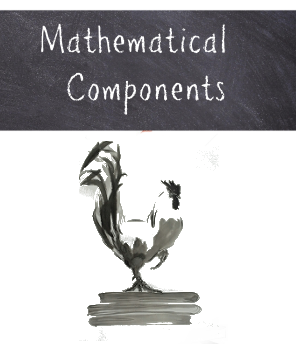Objective of this school
Give you access to the Mathematical Components library
- formalization techniques
- proof language
- familiarize with some theories
Why another library? Why another language?
- large, consistent, library organized as a programming language library (interfaces, overload, naming conventions, ...)
- maintainable in the long term (compact, stable, ...)
- validated on large formalization projects
Captatio benevolentiae: this is not standard Coq
- things are done differently, very differently, than usual
- it is not easy to appreciate the benefits on small examples, but we will try hard ;-)
- not enough time to explain eveything, we may focus on intuition rather than technical details (aka handwaving)
Roadmap of the first lesson
- formalization technique: boolean reflection (aka small scale reflection)
- proof language: basic SSReflect (part 1)
- libraries: conventions, notations, ad-hoc polymorphism
Boolean reflection
- when a concept is
computable
we represent it as a computable function (a program), not as an inductive relation - Coq knows how to compute, even symbolically, and computation is a very stable form of automation
- expressions in bool are a
simple
concept in type theory- Excluded Middle (EM) just holds
- Uniqueness of Identity Proofs holds uniformly
Last, the proofs of these predicates are irrelevant (i.e. unique). This means that we can form subtypes without problems. E.g. the in habitants of the subtype of prime numbers { x | prime x = true } are pairs, the number (relevant) and the proof (always erefl true). Hence when we compare these pairs we can ignore the proof part, that is, prime numbers behave exactly as numbers.
A way to see this is that we are using Coq as a logical framework and that we are setting up an environment where one can reason classically (as in set theory, EM, subsets..) but also take advantage of computations as valid reasoning steps (unlike set theory TT manipulates effective programs)
The first predicate: leq
- order relation on nat is a program
- if-is-then syntax (simply a 2-way match-with-end)
- .+1 syntax (postfix notations .something are recurrent)
- these examples, to stay simple, are a bit artificial
- in the library the same concepts are defeined in a slightly different way, but following the same ideas
The first proof about leq
- ... = true to
state
something - proof by computation
- by [] to say, provable by trivial means (no mean is inside ).
- by tac to say: tac must solve the goal (up to trivial leftovers)
Another lemma about leq
- equality as a double implication
- naming convention
It is nice to have a lemma, it is even better to don't need it
- elim with naming and automatic clear of n
- indentation for subgoals
- no need to mention lemmas proved by computation
- apply, rewrite
Connectives for booleans
- since we want statements be in bool, we need to be able to form longer sentences with our basic predicates (like leq) and stay in bool
- notations &&, || and ~~
Proofs by truth tables
- we can use EM to reason about boolean predicates and connectives
- move=> name
- case:
- move=> /=
- naming convention: C suffix
- C for commutativity
- A for associativity
- K for cancellation
truth tableproofs, it is handy to combine calls to case with ;, as we do in the last line.
Recap: formalization approach and basic tactics
- boolean predicates and connectives
- think
up to
computation - case, elim, move, rewrite
- if-is-then-else, .+1, &&, ||, ~~
- naming convetions C, foo0n, foon0, fooSS
The real MathComp library
Things to know:
- Search something inside library
- patterns, eg _ <= _
- names, eg "SS"
- constants, eg leq
- a < b is a notation for a.+1 <= b
- _ == _ stands for computable equality (overloaded)
- _ != _ is ~~ (_ == _)
- is_true coercion
- rewrite /concept to unfold
up todefinitions like commutative. The pattern (_ + _ = _ + _) won't work. It's sad, it may be fidex one day, but now you know it. Search for
Cif you need a commutativity law.
Equality
- privileged role (many lemmas are stated with = or is_true)
- the eqP view:
is_true (a == b) <-> a = b
- move=> /eqP (both directions, on hyps)
- apply/eqP (both directions, on goal)
- move=> /view name to name after applying the view
- notation .*2
- rewrite lem1 lem2 to chain rules
A little bit of gimmicks
- connectives like && have a view as well
- andP and []
- move: to move back down to the goal
Forward steps:
- have
- move: (f x)
- move=> {}H
Sequences
- many notations
Polymorphic lists
- no assumptions on T
- we can use => ... // to kill a goal
- we can use => ... /= to simplify a goal
Ad-hoc polymorphic lists
- T : Type |- l : list T v.s. T : eqType |- l : list T
- eqType means: a type with a decidable equality _ == _
- if T is an eqType then list T also is an eqType
- x \in l requires the type of x to be an eqType
- overloaded as (_ == _)
Working with the \in notation
- pushing \in with inE
- rewrite flag !
- rewrite !inE idiom
- \notin notation
